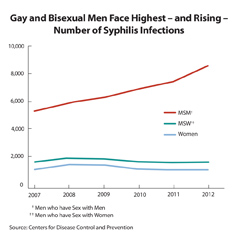The Centers for Disease Control and Prevention released their annual snapshot on sexually transmitted diseases (STDs) and the findings do not bode well for young people, or men who have sex with men (MSM). Statistics reveal a jump in infections of gonorrhea and syphilis.
“Youth bear a disproportionate share of sexually transmitted infections and also account for a substantial proportion of new STDs,” said Dr. Eloisa Llata, Medical Epidemiologist, CDC, Division of STD Prevention, who noted that all STDs are preventable and most are curable.
Many do not know they’re infected because sexually transmitted infections often have no symptoms. Llata said that young people could protect themselves by getting tested, reducing risk behaviors and getting vaccinated against HPV.
The CDC’s annual STD report serves as an overview, summarizing the national sexually transmitted disease surveillance data for 2012, and is primarily focused on chlamydia, gonorrhea and syphilis.
The CDC said that during the 1970’s to the late 1990’s, gonorrhea rates declined considerably and then they plateaued for about 10 years. In 2009, rates were the lowest ever recorded. But since 2009, they have seen rates of gonorrhea increase slightly each year for an overall increase of about 10 percent since 2009.
Although chlamydia rates were stable overall compared to 2011, 1.42 million cases were reported in 2012 — the greatest number of cases for any condition ever reported to CDC. The CDC continued to see increases in gonorrhea rates by four percent from 2011-2012, with higher increases in men.
“An overall increase of 12 percent in reported syphilis cases from 2011 to 2012 were seen, in large part contributed by increases in men who have sex with men,” said Llata.
A similar increase of infections among men was found when tracking both primary, secondary and congenital syphilis. After seeing declines of primary and secondary syphilis during the 1990’s, rates began to increase in 2001. There was a slight decrease in 2010 and rates in 2011 were unchanged from 2010.
“However, in 2012 the rate increased 11 percent and this increase was solely among men in whom rates increased overall 14. 8 percent,” said Llata, adding that, “Rates among women remained unchanged in the last year.”
LLata said that rates of congenital syphilis in 2012 marked the lowest rate ever recorded since 1988, when the case definition for congenital syphilis was changed. Rates decreased 10 percent between 2011 and 2012 and overall 26 percent since 2008.
While STDs threaten the health and well being of millions of Americans overall, young people bear the greatest burden of all three STDs. Youth aged 15-24 have the highest rates of chlamydia and gonorrhea, and those aged 20-24 have the highest rates of syphilis. The health consequences of STDs can be particularly serious for young women. CDC estimates that 24,000 women become infertile each year due to undiagnosed/untreated STDs.
“Greater awareness and action is needed at all levels to ensure good health for America’s youth and others disproportionately impacted by STDs,” said Llata.
And those who are already battling an STD are at least two to five times more likely than uninfected people to acquire HIV if they are exposed to the virus through sexual contact.
For example, STDs like syphilis or herpes that are associated with genital ulcers result in breaks in the genital tract lining or skin. These breaks can serve as an entry for HIV. STDs also appear to increase the risk of an HIV-positive person transmitting the virus to his or her sex partners.
Studies have shown that HIV-positive individuals who are also infected with other STDs are particularly likely to shed HIV in their genital secretions.
“Evidence from intervention studies indicates that detecting and treating STDs may reduce HIV transmission,” said Llata. “STD prevention, testing and treatment can play a vital role in comprehensive programs to prevent sexual transmission of HIV.”
Source








[…] Young People Bear Brunt As CDC Releases New Rates of STDs […]
Young People Bear Brunt As CDC Releases New Rates of STDs:
The Centers for Disease Control and Prevention re… http://t.co/iMTVpOqjn8
Young People Bear Brunt As CDC Releases New Rates of STDs:
The Centers for Disease Control and Prevention re… http://t.co/8WJRPSvhWQ
But of course the folks at AHF will tell you that these alarming statistics are much less important than the far smaller per capita incidence of these diseases in porn performers, which is a national emergency in need of immediate government intervention.
How about we try some science-based comprehensive sex-ed in public schools for a change? I have a feeling we’ll see those numbers improve if we do.